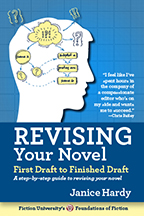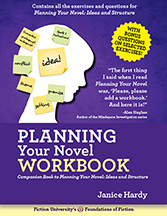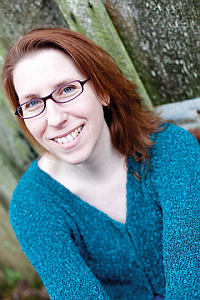When it comes to writing, we often have to find the right balance of elements. We’ve talked before about finding the right balance for our story’s descriptions, our characters’ emotions, and even real-world references.
Too much of an element can slow down our story’s pace, undercut tension, or create a feeling of melodrama. Too little of an element can leave readers confused or unconnected to the story and characters.
Today, I’m excited to welcome back Janice Hardy for another entry in her short series of monthly posts here. Last time, she shared her advice for planning the end of a story to figure out its plot.
This month’s post focuses on revision, specifically the element of backstory for our characters. Too much backstory slows the pace, can feel irrelevant, and lead to repetition. Too little backstory can leave readers in the dark about characters’ motivations.
She’s sharing her two-step process for how to make the backstory less likely to slow our story’s pace, as well as tips for how to hide backstory and when to know we need more. Please welcome Janice Hardy! *smile*
*****
How to Balance Your Backstory During Revisions
Everybody has a backstory. In fiction though, that past isn’t always relevant, even if it is interesting.
Readers like to see a story moving, and stopping to explain a character’s history tends to bog the narrative down. Too much backstory is high on the list of why agents reject a manuscript, and many advise to cut all backstory from the first fifty pages. This is why it’s critical to find the right backstory balance.
Step One: Eliminate Unnecessary Backstory
Once you’ve identified any unnecessary backstory in a scene, you have three choices:
- cut it
- move it to where it is relevant
- make it relevant in that scene
Your protagonist’s character arc can indicate which aspects of the character’s personality are the most relevant, and guide you in gauging the right backstory needed.
If you’re unsure if the backstory is unnecessary or not, consider:
- How Does It Affect the Scene’s Goal?
Backstory that affects motivation feels natural because it has a place in the story. It matters to the character and to the things readers care about. If the backstory has no bearing on what the protagonist is trying to do in that scene (either directly or by affecting a decision made in that scene) then it’s probably not needed.
- Were Any of the Scene’s Characters Involved in the Backstory?
If the backstory changes the way readers (or even characters) see the scene, it might be worth keeping. Unless of course, that change steals tension or reveals a secret better left a mystery.
- How Does the Point-of-View Character Feel about the Backstory?
People think about the past when it has relevance on the present. If the point-of-view character doesn’t care, or isn’t affected by the backstory, there’s no need to reveal it.
Step Two: Revise Backstory to Show, Not Tell
Take a look at any remaining backstory and ask: is it showing or telling the information? Backstory is a common place for told prose to sneak in as you explain the history and why it matters to the character at that time.
Look for common telling words, such as “in order to” or “because” or “which” or “”once” to help spot backstory. If it feels like you’re stopping the story to explain something, odds are it’s telling, not showing.
Ways to Hide the Backstory
If you have backstory that needs to be there, try slipping it into the text in small bites, or disguise it as something else.
Background the Backstory:
Hiding the backstory in plain sight is a handy trick to get the information into the story without stopping the story to explain it.
For example, if you wanted to tell readers about the terrible past of your protagonist, and that she spent nine years in an underground prison, think of the things that might have affected her because of that experience. How might that change her behavior in the scene? Is she extra sensitive to the light? Claustrophobic? Very good at getting around when she can’t see well?
By putting your backstory in the background (backgrounding), you can flesh out your characters and show their history without stopping the story to explain it. Better still, you’ll leave enough tantalizing hints that readers eventually want to know the whole story.
Drop Teasing Hints:
Instead of revealing all of a character’s past, try dropping hints here and there to tease readers so they want to know the history. Look for places to toss off a casual comment or exhibit an interesting skill that’s never explained. After a while, readers will be so intrigued they’ll have no problem with the story pausing while this history is explained in more depth.
Be wary of being too vague with hints and clues. Find the right balance between a tease and being too cryptic to be understood, which can turn readers off and confuse them. Make readers think, “Ooo, what’s that all about?” not “What the heck are they talking about?”
If You Need More Backstory, Not Less
There are rare instances when a novel actually needs more backstory, so if analyzing your backstory reveals certain scenes require additional information to fully understand them, go ahead and flesh out those details. Just make sure what’s being added is truly necessary.
Red flags that a scene needs more backstory include:
- Readers Are Having a Hard Time Understanding the Importance of the Scene.
If your beta readers or critique partners aren’t catching the significance of a scene, or don’t know why something matters, you might need a little backstory to explain the motives or significance.
- The Critical Information Has Never Been Discussed or Shown.
While most of a character’s past can be shown in how she interacts with the world, sometimes the only way to convey that information is by hearing the backstory of that character.
- The Backstory Is Complicated.
In genre novels with a lot of world building, it’s more common to see an above-average amount of backstory. It’s much harder to glean clues from how a character acts when the world isn’t a world readers are familiar with.
Backstory isn’t just explaining the characters’ history, it’s about showing the experiences that shaped their lives and made them act the way they do. Backstory affecting motivation feels natural because it has a place in the story. It matters to the character and to the things readers care about.
You want to mention the things that are driving characters to act, not just things that happened in their pasts. Pick what’s important both to the character and to the story itself.
*****
Win a 10-Page Critique From Janice Hardy
Three Books. Three Months. Three Chances to Win.
 To celebrate the release of my newest writing books, I’m going on a three-month blog tour–and each month, one lucky winner will receive a 10-page critique from me.
To celebrate the release of my newest writing books, I’m going on a three-month blog tour–and each month, one lucky winner will receive a 10-page critique from me.
It’s easy to enter. Simply visit leave a comment and enter the drawing via Rafflecopter. One entry per blog, but you can enter on every stop on the tour. At the end of each month, I’ll randomly choose a winner.
 Looking for tips on revising your novel?
Looking for tips on revising your novel?
Check out my new book Revising Your Novel: First Draft to Finished Draft, a series of self-guided workshops that help you revise your manuscript into a finished novel.
Still working on your idea? Then try my just-released Planning Your Novel Workbook.
*****
 Janice Hardy is the award-winning author of The Healing Wars trilogy and the Foundations of Fiction series, including Planning Your Novel: Ideas and Structure, a self-guided workshop for planning or revising a novel, the companion Planning Your Novel Workbook, Revising Your Novel: First Draft to Finished Draft and the upcoming Understanding Show, Don’t Tell (And Really Getting It).
Janice Hardy is the award-winning author of The Healing Wars trilogy and the Foundations of Fiction series, including Planning Your Novel: Ideas and Structure, a self-guided workshop for planning or revising a novel, the companion Planning Your Novel Workbook, Revising Your Novel: First Draft to Finished Draft and the upcoming Understanding Show, Don’t Tell (And Really Getting It).
She’s also the founder of the writing site, Fiction University. For more advice and helpful writing tips, visit her at www.fiction-university.com or @Janice_Hardy.
Website | Facebook | Twitter | Goodreads
Amazon | Barnes & Noble | iTunes | Indie Bound
*****
Thank you, Janice! Given the excerpt you shared with us here, I can’t wait to dig into your revision book. This is amazing information! In fact, I just got an idea for another post based on the point you made here for the story purpose of backstory. *grin*
We struggle constantly with finding the right balance of elements for our story, and backstory is no exception. But with Janice’s help, we can not only ensure that our backstory is relevant, but also improve its flow with the rest of our story so what we do include doesn’t slow down our pacing.
And believe it or not, I have seen examples of too little backstory in my editing work with clients, so I’m glad Janice included those tips as well. The goal isn’t to eliminate backstory but to make sure it plays nicely with the rest of the story. That way our readers remain engaged with the characters and curious enough to keep turning pages. *smile*
How much backstory sneaks into your first drafts? Are you an “add more later” or a “dump it all in and sort it out later” type of writer? Are you able to tell when your backstory is off-balance, or do you rely on feedback from beta readers or editors? Do you have any tips for finding the right balance? Do you have any questions for Janice?

